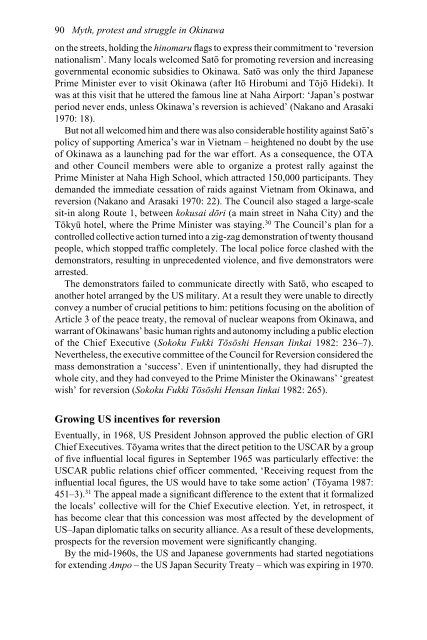Myth, Protest and Struggle in Okinawa
Myth, Protest and Struggle in Okinawa
Myth, Protest and Struggle in Okinawa
You also want an ePaper? Increase the reach of your titles
YUMPU automatically turns print PDFs into web optimized ePapers that Google loves.
90 <strong>Myth</strong>, protest <strong>and</strong> struggle <strong>in</strong> Ok<strong>in</strong>awa<br />
on the streets, hold<strong>in</strong>g the h<strong>in</strong>omaru flags to express their commitment to ‘reversion<br />
nationalism’. Many locals welcomed Satō for promot<strong>in</strong>g reversion <strong>and</strong> <strong>in</strong>creas<strong>in</strong>g<br />
governmental economic subsidies to Ok<strong>in</strong>awa. Satō was only the third Japanese<br />
Prime M<strong>in</strong>ister ever to visit Ok<strong>in</strong>awa (after Itō Hirobumi <strong>and</strong> Tōjō Hideki). It<br />
was at this visit that he uttered the famous l<strong>in</strong>e at Naha Airport: ‘Japan’s postwar<br />
period never ends, unless Ok<strong>in</strong>awa’s reversion is achieved’ (Nakano <strong>and</strong> Arasaki<br />
1970: 18).<br />
But not all welcomed him <strong>and</strong> there was also considerable hostility aga<strong>in</strong>st Satō’s<br />
policy of support<strong>in</strong>g America’s war <strong>in</strong> Vietnam – heightened no doubt by the use<br />
of Ok<strong>in</strong>awa as a launch<strong>in</strong>g pad for the war effort. As a consequence, the OTA<br />
<strong>and</strong> other Council members were able to organize a protest rally aga<strong>in</strong>st the<br />
Prime M<strong>in</strong>ister at Naha High School, which attracted 150,000 participants. They<br />
dem<strong>and</strong>ed the immediate cessation of raids aga<strong>in</strong>st Vietnam from Ok<strong>in</strong>awa, <strong>and</strong><br />
reversion (Nakano <strong>and</strong> Arasaki 1970: 22). The Council also staged a large-scale<br />
sit-<strong>in</strong> along Route 1, between kokusai dōri (a ma<strong>in</strong> street <strong>in</strong> Naha City) <strong>and</strong> the<br />
Tōkyū hotel, where the Prime M<strong>in</strong>ister was stay<strong>in</strong>g. 30 The Council’s plan for a<br />
controlled collective action turned <strong>in</strong>to a zig-zag demonstration of twenty thous<strong>and</strong><br />
people, which stopped traffic completely. The local police force clashed with the<br />
demonstrators, result<strong>in</strong>g <strong>in</strong> unprecedented violence, <strong>and</strong> five demonstrators were<br />
arrested.<br />
The demonstrators failed to communicate directly with Satō, who escaped to<br />
another hotel arranged by the US military. At a result they were unable to directly<br />
convey a number of crucial petitions to him: petitions focus<strong>in</strong>g on the abolition of<br />
Article 3 of the peace treaty, the removal of nuclear weapons from Ok<strong>in</strong>awa, <strong>and</strong><br />
warrant of Ok<strong>in</strong>awans’ basic human rights <strong>and</strong> autonomy <strong>in</strong>clud<strong>in</strong>g a public election<br />
of the Chief Executive (Sokoku Fukki Tōsōshi Hensan I<strong>in</strong>kai 1982: 236–7).<br />
Nevertheless, the executive committee of the Council for Reversion considered the<br />
mass demonstration a ‘success’. Even if un<strong>in</strong>tentionally, they had disrupted the<br />
whole city, <strong>and</strong> they had conveyed to the Prime M<strong>in</strong>ister the Ok<strong>in</strong>awans’ ‘greatest<br />
wish’ for reversion (Sokoku Fukki Tōsōshi Hensan I<strong>in</strong>kai 1982: 265).<br />
Grow<strong>in</strong>g US <strong>in</strong>centives for reversion<br />
Eventually, <strong>in</strong> 1968, US President Johnson approved the public election of GRI<br />
Chief Executives. Tōyama writes that the direct petition to the USCAR by a group<br />
of five <strong>in</strong>fluential local figures <strong>in</strong> September 1965 was particularly effective: the<br />
USCAR public relations chief officer commented, ‘Receiv<strong>in</strong>g request from the<br />
<strong>in</strong>fluential local figures, the US would have to take some action’ (Tōyama 1987:<br />
451–3). 31 The appeal made a significant difference to the extent that it formalized<br />
the locals’ collective will for the Chief Executive election. Yet, <strong>in</strong> retrospect, it<br />
has become clear that this concession was most affected by the development of<br />
US–Japan diplomatic talks on security alliance. As a result of these developments,<br />
prospects for the reversion movement were significantly chang<strong>in</strong>g.<br />
By the mid-1960s, the US <strong>and</strong> Japanese governments had started negotiations<br />
for extend<strong>in</strong>g Ampo – the US Japan Security Treaty – which was expir<strong>in</strong>g <strong>in</strong> 1970.
















